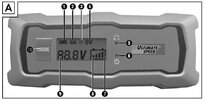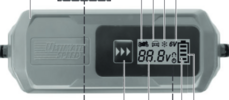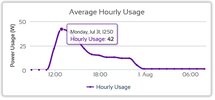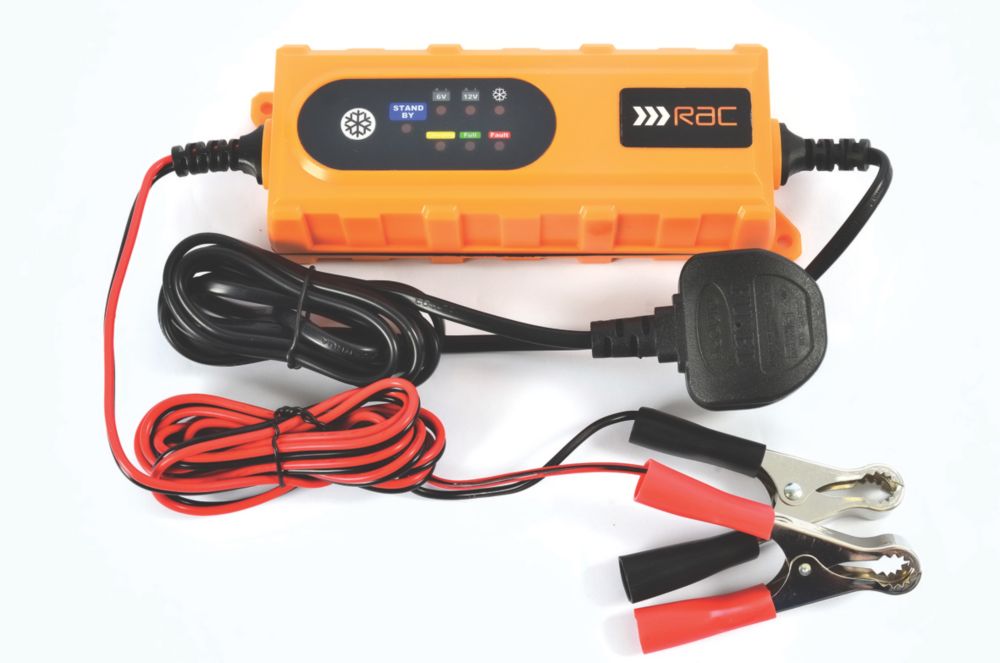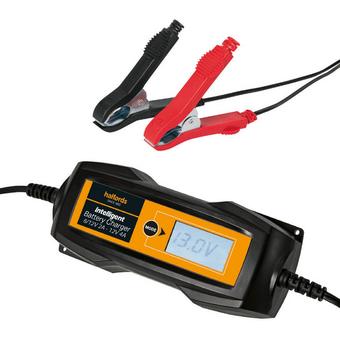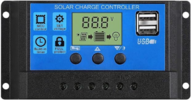- Joined
- 27 Jan 2008
- Messages
- 27,454
- Reaction score
- 3,320
- Location
- Llanfair Caereinion, Nr Welshpool
- Country

The bit on my Lidi charger to say suitable for AGM batteries is in the manual.
Most are stage chargers and it will have some thing like this
 this one it says is 7 stage, but in real terms there are 5 charge rates, under 10.5 volt the pulse charge, in real terms this is normally skipped, it will charge at 5 amp until 12.8 volt, which is still quite a low state of charge, then at 3 amp until 14.1 volt, then 0.8 amp until 14.4 volt and it will then alternate between 0.1 amp and 0.8 amp. The latter Lidi charger shown here does seem to return to the 3 amp charge rate if voltage drops, the old one did not, and the old one would alternate off and 0.1 volt when set for a battery under 12 Ah. Not tested new one.
this one it says is 7 stage, but in real terms there are 5 charge rates, under 10.5 volt the pulse charge, in real terms this is normally skipped, it will charge at 5 amp until 12.8 volt, which is still quite a low state of charge, then at 3 amp until 14.1 volt, then 0.8 amp until 14.4 volt and it will then alternate between 0.1 amp and 0.8 amp. The latter Lidi charger shown here does seem to return to the 3 amp charge rate if voltage drops, the old one did not, and the old one would alternate off and 0.1 volt when set for a battery under 12 Ah. Not tested new one.
In the car the engine management controls the charge rate, but the big problem is the time taken to recharge. When something like a interior lamp has discharged a battery, I have used my energy monitor to see what is happening to the battery, and one can observe the mark/space ratio between 0.8 and 0.1 amp altering as it charges, the relatively new battery in the Jag when charged over Colvid would slowly increase the 0.1 amp time and decrease the 0.8 amp time until it would lift to 0.8 amp once a day. Always at same time, so clearly some thing in the Jag must turn on at that time.
But from when the LED display showed fully charged to when the 0.8 amp charge rate was just once a day, took some time, maybe a week, so this is the problem with lead acid, with batteries where one could top them up, we traditionally used a equalising charge once every couple of months, without this slowly the performance would drop off.
The was very evident with narrow boats, and owners would try to get a shore supply once a month to bring the batteries back up. All sorts if ideas were used to try and recharge the battery during the time the motor was running. Sterling made a alternator to battery unit which could pulse charge the battery and measure the decay rate to work out state of charge, with 3 x 140 Ah 12 volt lead acid they would start charging at 120 amp, but the problem is very soon after the rate has dropped to a few amp as the battery can't accept the charge fast.
Milk tankers and the like would use nickel iron batteries to be able to recharge fast. The vac pump would suck the milk in with engine stopped, and battery recharged while travelling to next farm, buses would also use nickel iron.
Sorry to say the battery charger shown is not suitable for AGM batteries, this one is, and states "Compatible batteries: Lead Acid, Wet, Gel, MF, EFB & AGM" however to recharge with a generator is not really going to work. My 3.2 kWh battery states maximum charge 2kW and maximum discharge 3 kW it is 50 volt and part of my solar system, and are very expensive to allow that charge and discharge rate, they are Lithium Iron Phosphate(LiFePO4) and need a special charger matched to the battery, and these can be charged in a couple of hours. But with lead acid of any type, looking at least 8 hours on charge every day.
In real terms you need more like 14 hours, milk floats, and fork lifts would need the batteries topping up quite a lot when recharging in 8 hours. What you are describing will not work for long. An inverter generator can still produce 230 volt at a tick over, so leaving running for 8 hours is not so bad, but non inverter to get 50 Hz need to run at a fixed speed, 6000 RPM divided by number of poles in the generator so 4 pole 3000 RPM and 6 pole 2000 RPM so even when only providing a few watt, it is still revving away.
So lead acid of any type does not seem to be what you need, only way to use lead acid is with solar panels or wind, as no one wants a generator running that long.
The Ultimate Speed ULGD 3 8 A1 is a multi-stage car battery charger that is suitable for charging and trickle charging up of 6 V or 12 V lead-acid batteries (batteries) with electrolyte solution (WET), electrolyte absorbent mats (AGM) or gel electrolyte (GEL)
It would be nice if it was written on the unit its self, but I have the 3.8 amp one in front of me, and it says nothing.The Ultimate Speed ULGD 5.0 D2 is a multi-level car & motorcycle battery charger, which is suitable for charging and trickle charging 6 V (3 cells) or 12 V (6 cells) lead acid batteries (maintenance-free batteries (MF), open) with electrolyte solution (WET), with electrolyte absorbing mats (AGM), with gel gel-type electrolyte (GEL) or calcium batteries. The device is not suitable for charging lithium-ion batteries! You can also regenerate discharged batteries (depending on the battery type). The car & motorcycle battery charger has a safety circuit against sparking and overheating. Keep these instructions in a safe place. Ensure you hand over all documentation when passing the product on to anyone else.
Most are stage chargers and it will have some thing like this
In the car the engine management controls the charge rate, but the big problem is the time taken to recharge. When something like a interior lamp has discharged a battery, I have used my energy monitor to see what is happening to the battery, and one can observe the mark/space ratio between 0.8 and 0.1 amp altering as it charges, the relatively new battery in the Jag when charged over Colvid would slowly increase the 0.1 amp time and decrease the 0.8 amp time until it would lift to 0.8 amp once a day. Always at same time, so clearly some thing in the Jag must turn on at that time.
But from when the LED display showed fully charged to when the 0.8 amp charge rate was just once a day, took some time, maybe a week, so this is the problem with lead acid, with batteries where one could top them up, we traditionally used a equalising charge once every couple of months, without this slowly the performance would drop off.
The was very evident with narrow boats, and owners would try to get a shore supply once a month to bring the batteries back up. All sorts if ideas were used to try and recharge the battery during the time the motor was running. Sterling made a alternator to battery unit which could pulse charge the battery and measure the decay rate to work out state of charge, with 3 x 140 Ah 12 volt lead acid they would start charging at 120 amp, but the problem is very soon after the rate has dropped to a few amp as the battery can't accept the charge fast.
Milk tankers and the like would use nickel iron batteries to be able to recharge fast. The vac pump would suck the milk in with engine stopped, and battery recharged while travelling to next farm, buses would also use nickel iron.
Sorry to say the battery charger shown is not suitable for AGM batteries, this one is, and states "Compatible batteries: Lead Acid, Wet, Gel, MF, EFB & AGM" however to recharge with a generator is not really going to work. My 3.2 kWh battery states maximum charge 2kW and maximum discharge 3 kW it is 50 volt and part of my solar system, and are very expensive to allow that charge and discharge rate, they are Lithium Iron Phosphate(LiFePO4) and need a special charger matched to the battery, and these can be charged in a couple of hours. But with lead acid of any type, looking at least 8 hours on charge every day.
In real terms you need more like 14 hours, milk floats, and fork lifts would need the batteries topping up quite a lot when recharging in 8 hours. What you are describing will not work for long. An inverter generator can still produce 230 volt at a tick over, so leaving running for 8 hours is not so bad, but non inverter to get 50 Hz need to run at a fixed speed, 6000 RPM divided by number of poles in the generator so 4 pole 3000 RPM and 6 pole 2000 RPM so even when only providing a few watt, it is still revving away.
So lead acid of any type does not seem to be what you need, only way to use lead acid is with solar panels or wind, as no one wants a generator running that long.

